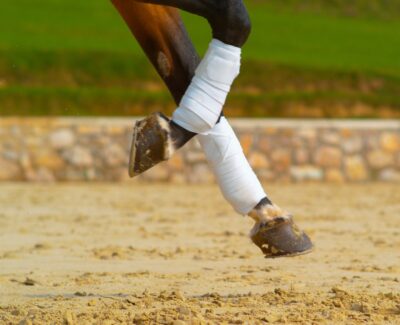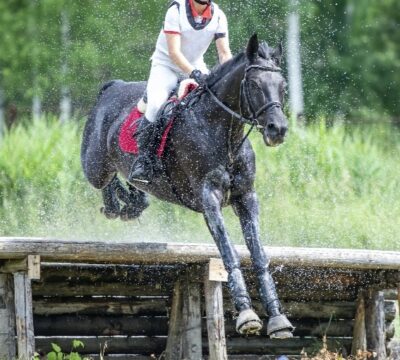Training and Management, Welfare
Boots and bandages – how do they affect my horse?
Rebecca Watson MSc RVN, asks how do boots and bandages affect the horse?
As prey animals, horses evolved to be highly athletic due to their flight response to predators, they can run and, they can jump out of the way of danger. A few thousand years later and with a little human influence, in the form of selective breeding, horses’ athletic ability has increased so they can run faster, and jump higher. However, the design of the horse, four relatively slim limbs under a large strong body can predispose them to injury of those delicate limbs.
Why use them?
Lameness is one of the most common reasons our horses are presented to veterinary surgeons, therefore, as horse owners and trainers we do our utmost to keep all four limbs healthy and functioning well. Particularly the lower limbs, where there is very little protection over the bones, tendons, and ligaments, other than a thin layer of skin and hair. This is where bandages and boots come into the equation.
You might you use bandages or boots for protection or support while your horse is:
- Exercising or competing
- Travelling
- Resting
- Injured
However, does your horse really need bandages or boots? Are you using them through necessity, peer pressure or simply fashion trends?
Bandages and boots can offer protection from most minor physical trauma, brushing or striking one limb against the other or, from knocking limbs on a fence or the inside of a lorry or trailer during transportation.
Bandages and boots can provide some support to the lower limbs, to help reduce swelling, whether that be after an injury (we know that bandaging a tendon injury in the immediate phase after it has occurred can help reduce the swelling and the subsequent lesion, which may have a positive effect on the outcome) or due to irregular inactivity, e.g. standing in a stable or a lorry for a prolonged period of time, when the horse is used to being turned out 24/7.
However, neither bandages nor boots can provide protection from concussive forces to the highly elastic tendons and ligaments that provide shock absorption when the horse is galloping or jumping. When cantering, there is a combined strain force on the tendons and ligaments in just one limb of more than 1000kg – this is even greater when galloping and jumping. Those are huge forces, impossible to ‘support’ by wrapping a bandage or applying a boot around the lower limb.
Some horses are more prone to injury during exercise than others, polo ponies or young, weak horses with under-developed balance and co-ordination for example or, event horses taking on large solid jumping obstacles that do not ‘give’ when hit. Bandages or boots will provide some protection in these instances.

Correct application of exercise bandages or boots is imperatve, too loose and they may slip or come undone, causing the horse to trip or fall, particularly during fast work. Applied too tightly they can cause rubs or discomfort and, restrict blood flow to the limb – they may even cause damage to the tendons.
You might be surprised to learn that there is very little scientific research around the application of bandages and boots and, their subsequent effect on the inner structures of your horse’s legs.
What we do know is, that covering your horse’s legs with bandages or boots increases the temperature of the area covered by as much as 30% during exercise, by trapping the heat on the inside next to the limb.
An Austrian study¹ found that skin temperature over the equine cannon bone increased significantly during exercise but, not at rest when a bandage or tendon boot was used. Just what the implications for this temperature increase holds for other anatomical structures in the area, such as tendons and ligaments remains to be determined.

Warming up a horse involves gradually increasing the heart rate and the blood circulating throughout the body including the structures in the limbs, to avoid injury. While it could be argued that the application of bandages during warm up would effectively speed up the process, what implications could this have for other structures above and below the bandaged area? Is there really any benefit from a ‘quick’ warm up?
The increase in temperature in the lower limb could be detrimental to the tendon fibres. Several studies have shown the core temperatures of the horse’s tendons can increase by 6-8ᵒC during hard exercise (such as galloping or jumping). If boots or bandages are worn, then this will also inhibit the natural cooling effect of air passing over the limbs as the horse moves, thus keeping the temperature of the tendons higher than normal.

An invitro study in Japan² showed that exposing tendon cells to temperatures of 48ᵒC resulted in the death of 80% of the cells – melting of the tendon fibres. If you do choose to use leg protection on your horse while exercising or competing, you should always ensure that it is for the shortest period of time possible and, removed immediately afterwards to prevent injury caused through excessive heat build-up in the tendons and ligaments.
Using cool running water over the limbs for 5 minutes is shown to reduce leg temperature more effectively than the application of ice for 5 minutes. If cold hosing facilities are available after exercise, or better still, standing in a river or a stream, then opt for that.
“exposing tendon cells to temperatures of 48ᵒC resulted in the death of 80% of the cells – melting the tendon fibres”
Commercially available cooling boots are a good option if there is no running water to hand but, be careful to check their temperature regularly and, remove them as soon as they begin to warm. Hot ‘cool boots’ are very effective at insulating the limbs and ‘locking in’ heat.
An alternative cooling therapy in the absence of running water, is the application of clay or gel-based leg cooling products. When applied to the limbs these substances dry out or evaporate carrying the heat away with them. Again, as with the cooling boots, some of the clay-based products can act as an insulating layer, and lock heat into the limb. It is best to wash or brush these off the legs as soon as they have dried.
Bandages and boots can help prevent penetrative injuries and reduce the effects of other external trauma however, remember that badly applied bandages or badly fitting boots are worse than none at all.
References
1. Westermann, S., Windsteig, V., Schramel, J.P. and Peham, C., 2014. Effect of a bandage or tendon boot on skin temperature of the metacarpus at rest and after exercise in horses. American journal of Veterinary Research, 75(4), pp.375-379.
2. Hosaka, Y., Ozoe, S., Kirisawa, R., Ueda, H., Takehana, K. and Yamaguchi, M., 2006. Effect of heat on synthesis of gelatinases and pro-inflammatory cytokines in equine tendinocytes. Biomedical Research, 27(5), pp.233-241

